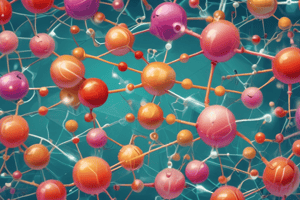Podcast
Questions and Answers
What is the recommended fasting period before venipuncture for measuring Total Cholesterol (TC) and High-Density Lipoproteins (HDL-C) levels?
What is the recommended fasting period before venipuncture for measuring Total Cholesterol (TC) and High-Density Lipoproteins (HDL-C) levels?
- 8 hours
- 6 hours
- 12 hours (correct)
- 24 hours
Which lipoproteins can be measured in non-fasting individuals?
Which lipoproteins can be measured in non-fasting individuals?
- Triglycerides (TAG)
- Total Cholesterol (TC)
- Low-Density Lipoproteins (LDL-C)
- High-Density Lipoproteins (HDL-C) (correct)
What percentage decrease in Triglycerides (TAG) is observed from upright to supine position?
What percentage decrease in Triglycerides (TAG) is observed from upright to supine position?
- 10%
- 50% (correct)
- 75%
- 25%
What causes hemoconcentration, as mentioned in the text?
What causes hemoconcentration, as mentioned in the text?
According to the National Cholesterol Education Program (NCEP), how long should patients be seated prior to venipuncture?
According to the National Cholesterol Education Program (NCEP), how long should patients be seated prior to venipuncture?
What is the recommended fasting period before venipuncture for measuring Triglycerides (TAG) and Low-Density Lipoproteins (LDL-C) levels?
What is the recommended fasting period before venipuncture for measuring Triglycerides (TAG) and Low-Density Lipoproteins (LDL-C) levels?
What effect does estrogen have on lipoproteins?
What effect does estrogen have on lipoproteins?
Which lipoproteins can be measured in non-fasting individuals?
Which lipoproteins can be measured in non-fasting individuals?
What effect do postural changes have on Triglycerides (TAG)?
What effect do postural changes have on Triglycerides (TAG)?
What should not be applied for longer than a minute or two, if possible, according to the text?
What should not be applied for longer than a minute or two, if possible, according to the text?
Flashcards
Fasting for TC and HDL-C
Fasting for TC and HDL-C
The recommended fasting period before a blood test to measure total cholesterol (TC) and high-density lipoprotein (HDL-C) levels is 12 hours.
HDL-C measurement
HDL-C measurement
High-density lipoprotein (HDL-C) levels can be measured even without fasting before a blood test.
Triglycerides and Posture
Triglycerides and Posture
Triglyceride levels can be measured without fasting. However, it's important to note that the triglyceride levels decrease significantly by almost 50% when a person goes from an upright to supine position.
Hemoconcentration
Hemoconcentration
Signup and view all the flashcards
NCEP Seated Time
NCEP Seated Time
Signup and view all the flashcards
Fasting for TAG and LDL-C
Fasting for TAG and LDL-C
Signup and view all the flashcards
Estrogen and Lipoproteins
Estrogen and Lipoproteins
Signup and view all the flashcards
Non-Fasting Lipids
Non-Fasting Lipids
Signup and view all the flashcards
Postural Effects on TAG
Postural Effects on TAG
Signup and view all the flashcards
Tourniquet Duration
Tourniquet Duration
Signup and view all the flashcards
Study Notes
Lipids and Lipoproteins
- Lipids and lipoproteins are important indicators of coronary heart disease (CHD) risk.
- The lipid profile recommended for initial screening in adults (age 20 or older) includes:
- Total Cholesterol (TC)
- Low-Density Lipoprotein (LDL)
- High-Density Lipoprotein (HDL)
- Triglycerides (TAG)
- Testing should be repeated at least once every 5 years.
Major Forms of Lipids
- Triglycerides: main storage form of lipid in humans.
- Cholesterol: part of the cell membrane; parent chain for cholesterol-based hormones (e.g. aldosterone, cortisol, sex hormones).
- Phospholipids: most abundant lipid in humans.
- Fatty Acids: building blocks of lipids.
- Fat Soluble Vitamins: A, D, E, and K.
Blood Sampling and Storage
- Individuals should be on their usual diet for 2 weeks and be neither gaining nor losing weight prior to cholesterol measurement.
- Effects of dietary modification take several weeks to become apparent.
- Certain drugs, such as oral contraceptives, postmenopausal estrogens, and some antihypertensive drugs, significantly alter lipid levels.
Studying That Suits You
Use AI to generate personalized quizzes and flashcards to suit your learning preferences.




